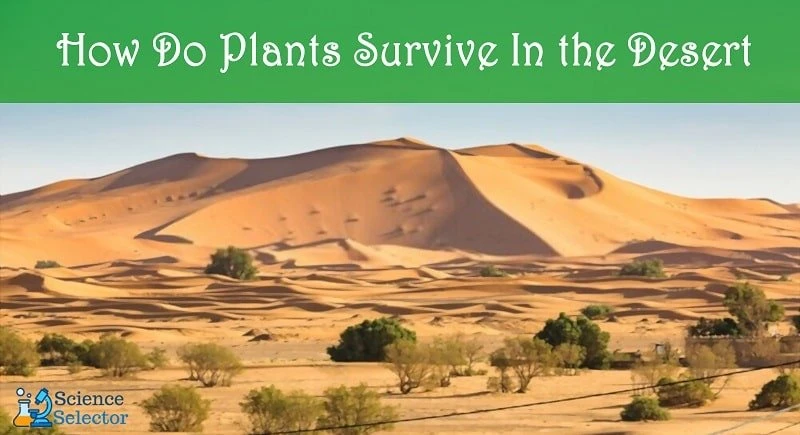reviewed by Christina Lopez
Once, California faced the longest drought of all time. The drought lasted for three years forcing the residents to develop new ways to deal with water. Some farmers opted to drill deep wells while others just left their lands fallow until it rained again. However, some farmers fled the harsh weather and moved to wetter and greener places.
Sometimes, and in some locations, nature does not offer enough water, making farmers employ technology and innovation to get solutions to the water problem. While those solutions seem to be so clever, many of them are imitations. Many desert plants have imitated the exact strategies to overcome the dry conditions, and they have done so for millions of years.
Contents
There are many deserts across the world. For instance, the Sonoran Desert stretches from Calif to Arizona and Mexico and the Sahara desert in Africa. Deserts experience very high temperatures of up to 40° Celsius, equivalent to 104° Fahrenheit during the day, while the nights are freezing; they can go below the freezing point. Deserts are mostly dry across the year, and even when they receive rain, deserts do not get much water.
While deserts experience very harsh weather, there is still diverse flora made up of plants called xerophytes. Xerophytes are desert plants that look pretty different from other plants because they have mechanisms that adapt to desert conditions. Like you would adapt when weather conditions change, for instance, wearing light clothes in summer to reduce heat retention, so do desert plants with different adaptations to the dry weather in the desert.
Some of the transformations of desert plants include succulent leaves, very deep or very shallow roots, and adaptations to encourage seed germination and dispersion, and other adaptions that we will be looking at in this article.

Native desert plants have incredible tricks that help them survive and thrive. These plants consistently cope with the arid conditions. Desert plants can go for over a year without receiving a single drop of water. Creosote is among the dominant shrub in some United States deserts. This plant reproduces by seeds, but it also reproduces by cloning.
The means through which these plants manage the dry conditions have caught the attention of many scientists who have discovered the different strategies plants use to survive in the desert.
The Mesquite tree, for instance, survives by increasing its ability to reproduce. Since the plant cannot move on its own, it depends on animals that feed on it then disperse its seeds through the feces.
Microbes, on the other hand, survive by depending on microbes found in the soil. These microbes help the plant to manage surviving in hot and dry weather conditions. Many wildflowers bet on their seeds, making them endure and germinate even the worst drought.
Desert plants do not look exactly like typical plants found in wetter areas. They have several mechanisms that make them able to survive in hot and dry weather. Desert plants differ in their seed structure, root structure, leaf structure and have an entirely different structure, including the stems and the plant’s surface. These are some of the ways that desert plants have adapted to survive in the desert.
Before the Mesquite tree’s seed takes root, it should fall in a conducive environment to grow to maturity. The seeds cannot walk on their own. They, therefore, depend on dispersal agents to find these favorable environments. One way that these seeds disperse is by riding the strong desert winds. However, the most common means that the Mesquite tree uses to reach its desired destination depends on the animals that feed on it.
When animals feed on mesquite seeds, they later spread the seeds in different parts of the desert through their dung. When the seeds stay in the animal’s stomach, that also helps in unstiffening the seed’s hard covering so that it becomes easy to sprout.
These plants produce hundreds and thousands of seedpods. The pods resemble green beans, but they have a sugary sweet taste. These pods also have a lot of nutrients attracting making them appealing to both animals and humans.
The seeds themselves have a tough covering. When animals feed on these sees, many cannot be destroyed by chewing and the digestion process. The hard seeds end up coming out whole and ready to grow. When animals move around, they scatter the seeds all over the place.
Staying in the gut also helps the seed in another way apart from scattering them around. The seeds have a solid coating that cannot allow water to penetrate. These seeds need water to germinate. The digestive juices help in breaking down the hard covering of the shell of the seed. When the animals finally excrete the seeds, they will be ready to sprout.
Mesquite plants survive best near arroyos and streams, so they need to land in such environments. Arroyos are dry gullies that hold water after it has rained. When an animal goes to have a drink and releases itself nearby, then the excreted seed is in luck. The animal dung is also a source of fertilizer that enhances the germination of the seeds.
Deep Roots
Deserts are dry for the better part of the year, receiving very little rain in winter and summer, and the rains produce very little water. Some plants survive in this condition by having roots that go very deep to tap water from groundwater. Groundwater is found far deep in the ground.
Velvet mesquite, also called Prosopisvelutina, is commonly found in the Sonoran desert located in Arizona. The Mesquite plant is commonly known as the desert bean plant. The roots of this shrub go as deep as 50 meters. Getting water from the ground source can sustain even a fully mature mesquite plant.
Shallow Roots
Succulents, like saguaro, are the most common roots found in the desert. These types of plants have extensive roots that do not grow deep into the soil. The roots of succulents grow horizontally. These plants can only grow as deep as the plant’s height to offer support. The roots do not develop any deeper.
Shallow roots modification enables them to absorb moisture from the earth across a large surface. Succulents need to absorb large amounts of water within short periods since the rains do not last long, and the soil dries fast under the extreme sun. The extensive shallow roots absorb as much water as possible before the rains disappear before the water evaporates from the soil.
The succulents grow far apart from each other to have enough space to stretch their roots. Succulents do not grow in clusters like other desert plants.
Fleshy Roots
Plants growing in arid areas also have fleshy, thick roots that store moisture and provide sufficient nutrients to thrive in the desert. The fleshy roots are referred to as tubers.
The leaves of xerophytes also have a special kind of leaves modified to survive desert conditions.
Leaf Size and Leaf Numbers
The leaves of desert plants are small in size. Some of these plants also have seasonal leaves, while some have no leaves at all. The species like little-leafed palo verde tree have leaves with a small surface area preventing it from losing large amounts of water through evaporation and transpiration.
Acacia and ocotillo, on the other hand, drop their leaves in the hot season. When there come better weather conditions, these summer deciduous plants regrow the leaves.
Also, plants like the cactus plant have spines instead of having left. The thorns reduce the evaporation of the cactus since evaporation only occurs through the bark and the stems. The thorns also offer more survival tactics for these desert plants.
Since desert plants are scarce and scattered, these plants need to adapt the mechanisms to protect them from being eaten. The thorns make it impossible for animals to chew on them. Most of these plants are also toxic, and they grow in non-accessible areas to prevent them from falling prey to humans and animals.
Light-colored Leaves
Dark colors retain too much heat; therefore, some desert flora has leaves with light-green color that help them keep away too much heat. The leaves also have a shiny surface that reflects light. The reflection prevents the leaves from retaining a lot of heat. The leaves of the sagebrush, for instance, have a light green color.
Adapted Stomata
Some leaves have adapted to the desert conditions by having very few quantities of stomata. Some plants have stomata that close in the daytime. These adaptations help the plant retain a lot of water that would have otherwise be lost by transpiration and evaporation.
The adaptation of closing stomata also enables plants like yuccas and xerophytic bromeliads to conduct CAM (Crassulacean Acid Metabolism) photosynthesis. The CAM plants open their stomata for carbon dioxide during the night and close them during the day as they conduct photosynthesis using the stored carbon dioxide. Since it is cooler at night, the plants lose very little water when they open the stomata at night.
The CAM plants can also halt their metabolism when the drought gets too harsh. When there is a complete lack of water, the stomata remain closed even at night, so there is neither water loss nor air exchange. However, the plant has a low level of metabolism in the moist tissues.
Waxy Leaves
Many desert plants have wax on the surface of their leaves. This wax reduces transpiration. One of the plants with this adaptation is called the creosote bush, also known as Larrea tridentate.
Hairy Leaves
The desert ironwood adapts to the arid areas with its leaves that have tiny hairs. The hairs reflect the sun’s rays. They also block the wind reducing transpiration.
Thick Leaves
Most succulents like the cacti have thick succulent leaves that have numerous vacuoles for maximum water retention. These plants can go for a very long time without getting any water since they use the stored water to survive.
Movable Leaves
Certain plants, e.g., the jojoba plant, can move around, allowing the sun only to reach the leaf edges. The movable leaves help to reduce evapotranspiration.
Thick, Fleshy Stems
Most succulents have thick fleshy stems that hold moisture helping the plants to survive desert conditions.
Waterproof and Hairy Surface
The stems of desert plants have hairy and waxy surfaces that limit water loss while protecting the plant from the wind.
Expandable Stems
Saguaro cactus and some other desert plants have stems that can expand. These stems are pleated, allowing them to expand and contract. This adaptation makes it possible for stems to retain more water during the rains and to prevent water loss when it is dry.
Lack of water affects plants’ growth, as you have seen or heard when there is prolonged drought. In some deserts, drought is the usual way of life, yet, different plants thrive. Desert plants have unique adaptations that not only enable them not only to survive but also to flourish in harsh desert weather conditions. The plants sprout, grow and stand the test of time despite the lack of enough water, hot daytimes, and cold nights characteristics of a desert climate.
 |
 |
 |
 |

About Christina Lopez
Christina Lopez grew up in the scenic city of Mountain View, California. For eighteen ascetic years, she refrained from eating meat until she discovered the exquisite delicacy of chicken thighs. Christina is a city finalist competitive pingpong player, an ocean diver, and an ex-pat in England and Japan. Currently, she is a computer science doctoral student. Christina writes late at night; most of her daytime is spent enchanting her magical herb garden.
 |
 |
 |
 |
Get new FREE Gifts. Or latest free growing e-books from our latest works.
Disable Ad block to reveal all the links. Once done, hit a button below
 |
 |
 |
 |